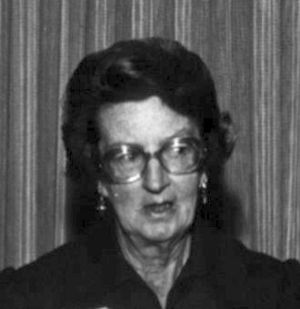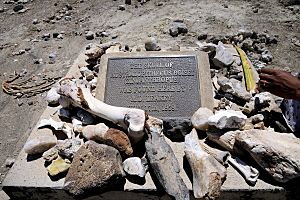Mary Leakey facts for kids
Quick facts for kids
Mary Leakey
|
|
|---|---|

Leakey in 1977
|
|
| Born |
Mary Douglas Nicol
6 February 1913 London, England
|
| Died | 9 December 1996 (aged 83) Nairobi, Kenya
|
| Nationality | British |
| Known for | Zinjanthropus fossil; Laetoli footprints |
| Spouse(s) | |
| Children |
|
| Awards |
|
| Scientific career | |
| Fields | Paleoanthropology |
Mary Douglas Leakey (born Mary Douglas Nicol, February 6, 1913 – December 9, 1996) was a British paleoanthropologist. This means she studied ancient humans and their ancestors. She made many important discoveries that helped us understand early human history.
Mary Leakey found the first fossilized skull of a creature called Proconsul. This was an ancient ape that many scientists believe is an ancestor to humans. She also discovered the strong Zinjanthropus skull at Olduvai Gorge in Tanzania, East Africa.
For much of her career, Mary worked with her husband, Louis Leakey. They explored Olduvai Gorge together. There, they found fossils of early human relatives, called hominines and hominins. They also found the stone tools these early humans made. Mary Leakey even created a special way to classify these stone tools.
One of her most famous finds was the Laetoli footprints. These were ancient human footprints preserved in volcanic ash. At the Laetoli site, she also found hominin fossils that were more than 3.75 million years old. During her life, Mary Leakey discovered 15 new types of animals and named a new genus (a group of related species).
After her husband passed away in 1972, Mary became the director of the excavations at Olduvai. She continued the family's work in paleoanthropology. She also trained her son, Richard Leakey, to follow in their footsteps.
Contents
Mary Leakey's Life Story
Growing Up and Early Discoveries
Mary Leakey was born in London, England, on February 6, 1913. Her parents were Erskine Edward Nicol and Cecilia Marion (Frere) Nicol. Her family traveled a lot to places like the United States, Italy, and Egypt. Her father painted watercolors to sell in England. Mary became very interested in Egyptology during these trips.
Her family had a history of interest in old things. On her mother's side, Mary was related to John Frere, an expert in ancient artifacts. She was also related to Sheppard Frere, a historian and archaeologist.
The Nicols spent a lot of time in southern France. Young Mary learned to speak French very well there. In 1925, when Mary was 12, her family stayed in a village called Les Eyzies. At that time, an archaeologist named Elie Peyrony was digging in a cave nearby. Mary was allowed to look through the leftover dirt from his dig. This is where her interest in prehistory and archaeology truly began. She started collecting ancient tools like points and scrapers. She even made her own system to sort them.
Later, her family moved to Cabrerets, another village in France. There, she met Abbé Lemozi, a local priest. He became her friend and teacher. They explored the Pech Merle cave together, where they saw amazing prehistoric paintings of bison and horses.
Learning and Training
In 1926, when Mary was thirteen, her father died. Mary and her mother moved back to London. Mary went to a Catholic school, but she often said she never passed an exam there! She was even expelled from two different schools. Once, it was for refusing to recite poetry. Another time, it was for causing an explosion in a chemistry lab. After this, her mother hired tutors, but they didn't have much success either.
Mary loved drawing and archaeology. But because of her school record, she couldn't get into a university. Her mother asked Oxford University about her, but they said it would be a waste of time. Mary didn't have any more contact with Oxford until they gave her an honorary degree much later in 1951.
Mary and her mother moved to Kensington in London. Mary went to lectures on archaeology at University College and the London Museum. She learned from famous archaeologists like Mortimer Wheeler.
Mary also applied to work on summer digs. Mortimer Wheeler was the first to accept her. She worked at St. Albans at a Roman site called Verulamium. Her next dig was at Hembury, a Neolithic site, where she trained for four years under Dorothy Liddell. Mary's drawings of tools for Liddell caught the eye of another archaeologist, Gertrude Caton Thompson. In 1932, Mary started working as an illustrator for Caton Thompson's book.
Family and Career

Through Gertrude Caton Thompson, Mary met Louis Leakey. Louis needed someone to draw pictures for his book, Adam's Ancestors. As they worked together, they fell in love. They married in 1936.
Mary and Louis Leakey had three sons: Jonathan (born 1940), Richard (born 1944), and Philip (born 1949). They also had a daughter who sadly died as a baby. The boys spent much of their childhood at archaeological sites. The Leakeys often worked and explored as a family. The children grew up loving freedom, just like their parents.
Mary and Louis published many findings together. However, Mary's important contributions were often credited to her husband. Louis Leakey passed away on October 1, 1972. After his death, Mary Leakey continued their archaeological work. She became a highly respected figure in paleoanthropology on her own. Her son, Richard Leakey, also became a paleoanthropologist, and Mary helped him start his career. Her other two sons, Jonathan and Philip, chose different paths.
Later Years
Mary Leakey died peacefully on December 9, 1996, in Nairobi, Kenya. She was 83 years old.
Important Discoveries

Mary Leakey gained early experience working at archaeological digs. From 1930 to 1934, she trained under Dorothy Liddell at Hembury. In 1934, she found the largest elephant tooth known in Britain at a dig in Swanscombe.
Through the 1930s to 1950s, Mary and Louis Leakey worked at many sites in central Kenya. These included Later Stone Age, Neolithic, and Iron Age sites like Hyrax Hill and Njoro River Cave. In October 1948, Mary found a Proconsul africanus skull on Rusinga Island. Mary Leakey also studied and published information about the Kondoa Irangi Rock Paintings in central Tanzania.
The Leakeys' most famous work was at Olduvai Gorge in Tanzania. This area is part of the Serengeti plains. At Olduvai, they found many stone tools. These ranged from very old Oldowan choppers to multi-purpose hand axes. The oldest tools they found were likely made by Homo habilis over two million years ago.
On July 17, 1959, Mary Leakey made a huge discovery. Her husband, Louis, was feeling sick at camp. Mary went out to the field by herself. She saw a piece of bone that looked like part of a skull, and it seemed to be from a hominid (an early human relative). She carefully brushed away the dirt. She found "two large teeth set in the curve of a jaw." She rushed back to camp, shouting, "I've got him!" They started digging the next day. Within weeks, they found a partial skull. Louis Leakey believed it was from a species that was an ancestor to humans, called australopithecines.
He named the find Zinjanthropus boisei, which means "East Africa man." Zinj is an old Arabic word for the East African coast. The name was later changed to Paranthropus boisei.
In the 1960s, the Leakeys began working with a young man named Kamoya Kimeu. Mary especially valued his skills. They taught him about paleontology and how to dig for fossils. Kamoya then trained many other Kenyan fossil finders. He became a very respected Kenyan paleontologist.
After her husband died in 1972, Mary Leakey continued their work at Olduvai and Laetoli. At the Laetoli site, she found hominin fossils that were more than 3.75 million years old.
From 1976 to 1981, Mary and her team uncovered the Laetoli hominin footprint trail. These footprints were made in a layer of volcanic ash about 3.6 million years ago. This was an incredible discovery, showing how early humans walked. The years after were spent researching, working on discoveries, and writing books.
Throughout her career, Mary Leakey discovered 15 new species of animals. She also identified one new genus. In 1979, she was chosen as an honorary member of the American Academy of Arts and Sciences.
Mary Leakey's Legacy
Mary Leakey's work continues to be remembered. In April 2013, the Royal Mail in the UK honored her. She was one of six people chosen for a special "Great Britons" commemorative postage stamp issue. Google also celebrated her 100th birthday on February 6, 2013, with a special Google doodle.
In the video game Civilization VI, Mary Leakey is a "Great Scientist." Players can recruit her to gain extra science and tourism from artifacts.
Awards and Honours
- Honorary D.Sc., University of the Witwatersrand, 1968
- Honorary DSSc, Yale, 1976
- Honorary D.Sc., University of Michigan, 1980
- Honorary D.Litt., Oxford, 1981
- Gold Medal of Society of Woman Geographers, 1975
- Linnaeus Gold Medal of the Royal Swedish Academy, 1978
- The Elizabeth Blackwell Award, 1980
- The Hubbard Medal of National Geographic Society, 1962 – jointly with Louis Leakey
- The Prestwich Medal, Geological Society of London, 1969 – jointly with Louis Leakey
Books Authored
- Excavations at Njoro River Cave (with Louis Leakey), 1950
- Olduvai Gorge: Excavations in Beds I and II, 1960–1963, 1971
- Olduvai Gorge: My Search for Early Man, 1979
- Africa's Vanishing Art: The Rock Paintings of Tanzania, 1983
- Disclosing the Past, 1984
See also
 In Spanish: Mary Leakey para niños
In Spanish: Mary Leakey para niños
- List of fossil sites
- List of human evolution fossils (with images)


